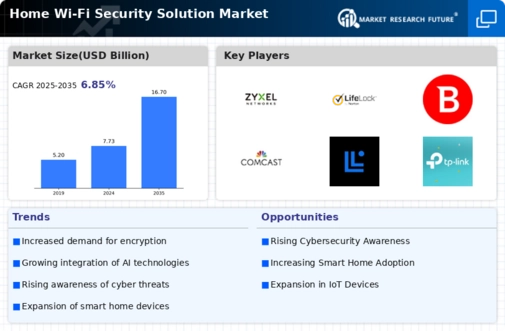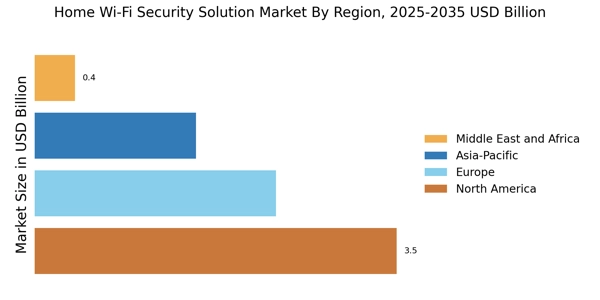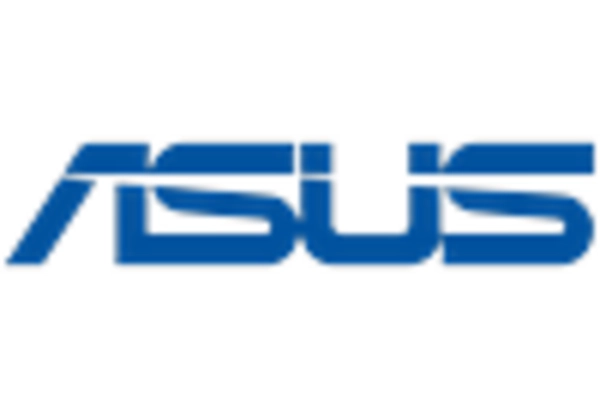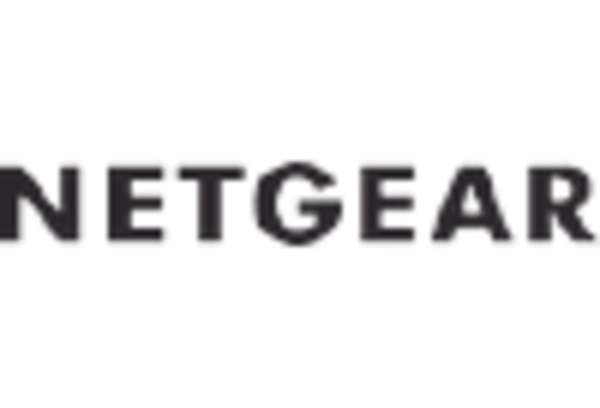Rising Cybersecurity Threats
The Home Wi-Fi Security Solution Market is experiencing a surge in demand due to the increasing prevalence of cybersecurity threats. As more individuals rely on home networks for work, education, and entertainment, the risk of cyberattacks has escalated. Reports indicate that cybercrime costs are projected to reach trillions of dollars annually, prompting consumers to seek robust security solutions. This heightened awareness of potential vulnerabilities drives the adoption of advanced home Wi-Fi security systems, which offer features such as encryption, firewalls, and intrusion detection. Consequently, the market is witnessing a significant uptick in investments aimed at enhancing the security of home networks, as consumers prioritize safeguarding their personal information and connected devices.
Growth of Remote Work Culture
The Home Wi-Fi Security Solution Market is significantly influenced by the growth of remote work culture. As organizations increasingly adopt flexible work arrangements, employees are utilizing home networks to access sensitive company data. This shift has led to a heightened focus on securing home Wi-Fi networks to prevent unauthorized access and data breaches. According to recent statistics, a substantial percentage of remote workers express concerns about the security of their home networks. This concern drives the demand for comprehensive security solutions that can protect both personal and professional information. As a result, companies are investing in innovative home Wi-Fi security technologies to cater to the needs of remote workers, thereby propelling market growth.
Regulatory Compliance and Standards
The Home Wi-Fi Security Solution Market is also influenced by the need for regulatory compliance and adherence to security standards. Governments and regulatory bodies are increasingly implementing guidelines to ensure the protection of consumer data and privacy. This regulatory landscape compels manufacturers and service providers to develop home Wi-Fi security solutions that meet specific compliance requirements. As a result, there is a growing demand for products that not only provide security but also align with legal standards. Market participants are investing in research and development to create solutions that comply with these regulations, thereby enhancing consumer trust and driving market growth. The emphasis on compliance is expected to shape the future of the home Wi-Fi security market, as stakeholders navigate the complexities of regulatory frameworks.
Increased Awareness of Privacy Issues
The Home Wi-Fi Security Solution Market is witnessing growth fueled by increased awareness of privacy issues among consumers. With the proliferation of smart devices and the Internet of Things (IoT), individuals are becoming more cognizant of the potential risks associated with inadequate network security. Surveys indicate that a significant portion of consumers is concerned about their online privacy and the security of their personal data. This awareness is prompting individuals to seek out home Wi-Fi security solutions that offer enhanced privacy features, such as VPNs and secure browsing options. As consumers prioritize their digital privacy, the demand for effective home Wi-Fi security solutions is expected to rise, driving innovation and competition within the market.
Technological Advancements in Security Solutions
The Home Wi-Fi Security Solution Market is benefiting from rapid technological advancements in security solutions. Innovations such as artificial intelligence, machine learning, and advanced encryption techniques are being integrated into home Wi-Fi security products. These technologies enhance the ability to detect and respond to threats in real-time, providing consumers with a higher level of protection. Market data suggests that the adoption of AI-driven security solutions is on the rise, as they offer proactive measures against potential cyber threats. This trend indicates a shift towards more sophisticated security systems that not only protect networks but also adapt to evolving threats. As technology continues to advance, the home Wi-Fi security market is likely to expand, offering consumers more effective and user-friendly solutions.


















Leave a Comment